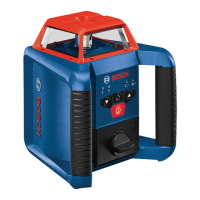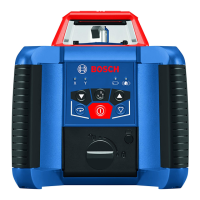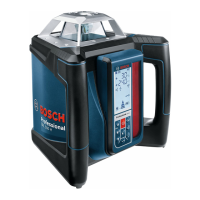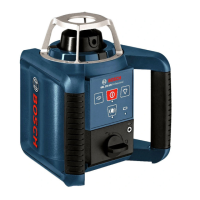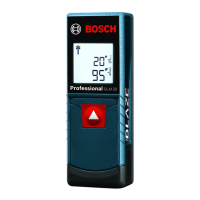-33-
For the exact positioning, measure the clear-
ance between the plumb beam and reference
line directly on the laser level using the laser
target plate (53). Measure the clearance be-
tween the plumb beam and reference line
again as far away as possible from the laser
level. Align the plumb beam in such a man-
ner that it has the same clearance to the ref-
erence line as when measured directly at the
laser level.
The right angle to the plumb beam (10) is in-
dicated by the variable laser beam (8).
Indicating a perpendicular/vertical plane
(see figure G)
To indicate a perpendicular or a vertical plane,
set up the laser level in the vertical position.
When the vertical plane is supposed to run at
a right angle to a reference line (e.g. a wall),
align the plumb beam (10) with this reference
line.
The perpendicular plane is indicated by the
variable laser beam (8).
Aligning a perpendicular/vertical plane
(see figure H)
To align the vertical laser line or the rotational
plane against a reference point on a wall, set
up the laser level in the vertical position, and
roughly align the laser line or the rotational
plane with the reference point. For precise
alignment with the reference point, turn the
rotational plane around the Y-axis (see “Turn-
ing the rotational plane when in the vertical
position”, page 25).
Working without the laser receiver
Under favorable light conditions (dark envi-
ronment) and for short distances, it is pos-
sible to work without the laser receiver. For
improved visibility of the laser beam, either
select line operation or point operation and
rotate the laser beam to the target location.
Working with the laser receiver
(see figure E)
In unfavorable lighting conditions (bright
environment, direct sunlight) and for larger
distances, use the laser receiver to improve
detection of the laser beam (42). When work-
ing with the laser receiver, select rotational
operation with the highest rotational speed.
Working outdoors (see figure E)
The laser receiver (42) should always be used
when working outdoors.
When working on unstable ground, mount the
laser level on the tripod (44). Always work
with the shock-warning function activated in
order to avoid faulty measurements in case
of ground movements or shocks to the laser
level.
Setting up formwork (see figure I)
Mount the laser level in the horizontal posi-
tion on a tripod (44) and set up the tripod
outside the formwork area. Select rotational
operation.
Secure the laser receiver (42) to a measuring
rod (43) with the holder. Position the measur-
ing rod on a reference point for the formwork.
Align the height of the laser receiver on the
measuring rod so that the variable laser beam
(8) of the laser level is indicated as “cen-
tered” (see operating instructions for the la-
ser receiver).
Then position the measuring rod with the la-
ser receiver, one after the other, at different
test locations on the formwork. Make sure
that the laser receiver remains in the same
position on the measuring rod.
Correct the height of the formwork until the
laser beam is indicated as “centered” at all
test locations.
Checking slopes (see figure J)
Mount the laser level in the horizontal posi-
tion on a tripod (44). Select rotational opera-
tion.
Set up the tripod with the laser level so that
the X-axis is aligned with the slope that is to
be checked.
Position the target slope as the slope for the
X-axis (see “Slope operation in the horizontal
position”, page 26).
Secure the laser receiver (42) to a measuring
rod (43) with the holder. Place the measuring
rod at the base of the slope surface.
Align the height of the laser receiver on the
measuring rod so that the variable laser beam
(8) of the laser level is indicated as “cen-
tered” (see operating instructions for the la-
ser receiver).
Then position the measuring rod with the la-
ser receiver, one after the other, at different
test locations on the slope surface. Make sure
that the laser receiver remains in the same po-
sition on the measuring rod.
If the slope of the plane is correct, the laser
beam will be indicated as “centered” at all
test locations.
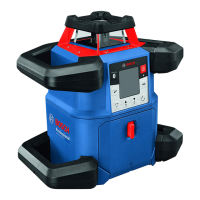
